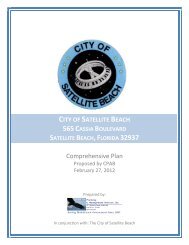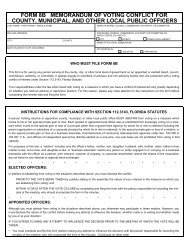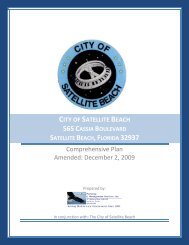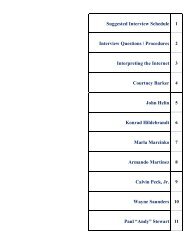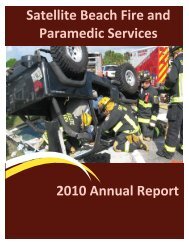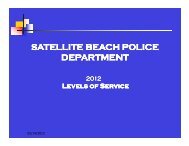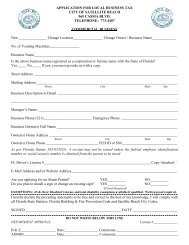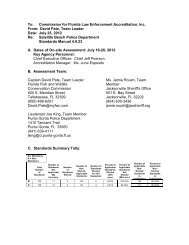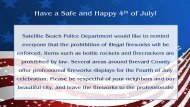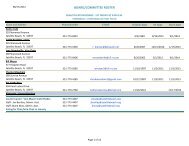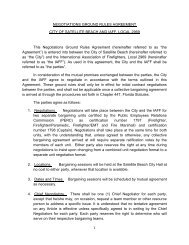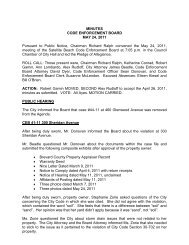Supporting Documents (Data and Analysis) - Satellite Beach
Supporting Documents (Data and Analysis) - Satellite Beach
Supporting Documents (Data and Analysis) - Satellite Beach
Create successful ePaper yourself
Turn your PDF publications into a flip-book with our unique Google optimized e-Paper software.
species of ibis, three species of both terns <strong>and</strong> gulls, four species of egret, <strong>and</strong> five species of heron.<br />
The Banana River area also supports a number of species listed as endangered or threatened. Table<br />
5-2 contains a listing of the endangered, threatened, <strong>and</strong> species of special concern which may be<br />
found in the Banana River area in the vicinity of <strong>Satellite</strong> <strong>Beach</strong>.<br />
The City of <strong>Satellite</strong> <strong>Beach</strong> is sited on a l<strong>and</strong>form commonly referred to as a barrier isl<strong>and</strong> or, to use<br />
the technically-correct term, the North Florida Coastal Str<strong>and</strong>. This area is characterized by a lowlying<br />
s<strong>and</strong> dune system bordered by the Atlantic Ocean to the east <strong>and</strong> the Indian River Lagoon<br />
system to the west. The eastern edge is a high-energy zone characterized by wind <strong>and</strong> salt spray.<br />
The plants which grow in this zone are influenced by <strong>and</strong> adapted to this high energy. Behind the<br />
second <strong>and</strong> third dune line (the first <strong>and</strong> second block west of A1A) the natural community is the<br />
s<strong>and</strong> scrub community. On the west side of the City, the original salt marsh has been completely<br />
replaced by filled l<strong>and</strong>, l<strong>and</strong>scaped suburban lots bordered by finger canals, <strong>and</strong> the spoil isl<strong>and</strong>. The<br />
undeveloped spoil isl<strong>and</strong> community was characterized by a high percentage of plant coverage<br />
represented by two alien plant species, Brazilian pepper <strong>and</strong> Australian pine, prior to development.<br />
The dominate ecosystem in the City is the suburban lot. While not normally included in an inventory<br />
of natural systems, it is included in this Plan, since the natural systems were almost completely<br />
eliminated when <strong>Satellite</strong> <strong>Beach</strong> was created <strong>and</strong> there is little natural system left.<br />
The only remaining original upl<strong>and</strong> habitat exceeding 1/4 acre in extent remaining in the City is<br />
seven acres of oak scrub on the thirty-five acre tract on which the <strong>Satellite</strong> <strong>Beach</strong> Sports <strong>and</strong><br />
Recreation Park is to be built. This remnant scrub, which harbors gopher tortoises <strong>and</strong> scrub jays,<br />
will be preserved <strong>and</strong> is being restored by the City from a badly degraded condition. Since all of the<br />
endangered species inventoried in the City occur as l<strong>and</strong>scape plants or as restorations on public<br />
l<strong>and</strong>s, it is important to underst<strong>and</strong> the growing awareness on the part of the public of the importance<br />
of protecting the native plant species as an integral part of the City's environment.<br />
Table 5-1 includes native plants found or expected to be found in <strong>Satellite</strong> <strong>Beach</strong>. Table 5-2 contains<br />
a listing of the endangered, threatened, <strong>and</strong> species of special concern which have been observed in<br />
<strong>Satellite</strong> <strong>Beach</strong>.<br />
Effect of Future Development on Habitat <strong>and</strong> Estuarine Pollution<br />
Future l<strong>and</strong> development within the city will be primarily in-fill development on scattered sites.<br />
There is generally no concentration of native vegetation or habitats that will be affected by such<br />
development. The only exception is the projected development of Lansing Isl<strong>and</strong>, lying between the<br />
Banana River <strong>and</strong> the Gr<strong>and</strong> Canal. While most of the isl<strong>and</strong> is mixed exotic vegetation, there is a<br />
significant mangrove fringe. The exotic species do not tend to support a wildlife population;<br />
however, the mangrove serves as a valuable habitat. All development within the City, including<br />
Lansing Isl<strong>and</strong>, must conform with stringent requirements administered by the FDEP. Therefore, the<br />
mangrove fringe will be protected as development occurs. As of 1997, the FDEP has required an<br />
approximate 54-foot wide conservation easement to be established <strong>and</strong> maintained along the<br />
shoreline of Lansing Isl<strong>and</strong> within <strong>Satellite</strong> <strong>Beach</strong>.<br />
Coastal Management/Conservation Element<br />
<strong>Data</strong> <strong>and</strong> <strong>Analysis</strong> 5-13



